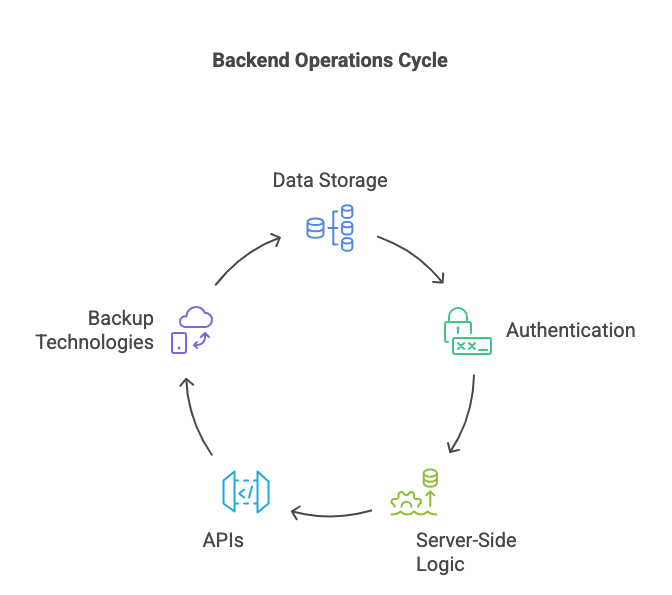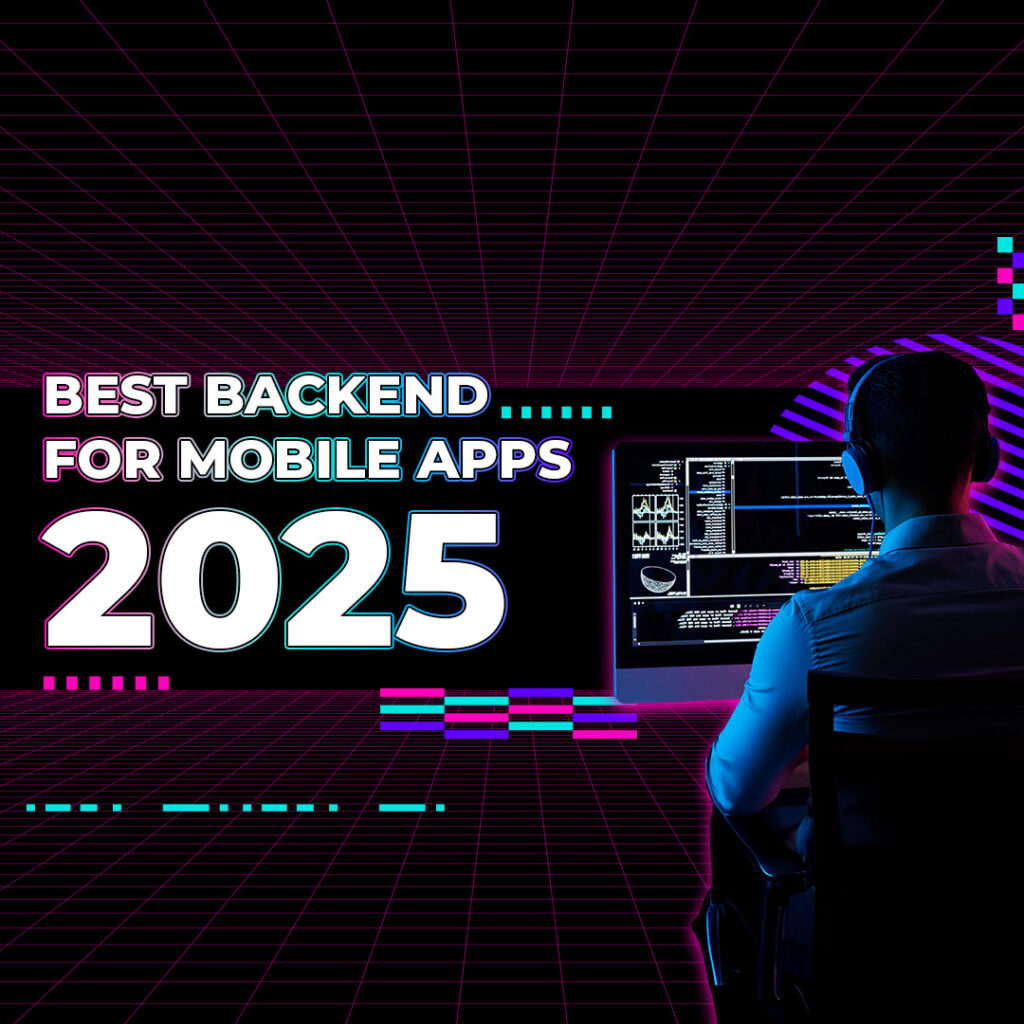|
Getting your Trinity Audio player ready...
|
When creating a mobile app, selecting suitable backend technology is potentially one of the most critical decisions you will have to make. The backend is essential because it determines how your app acts, scales, and maintains the security of user data. If backed with the right technology, your app can perform efficiently without hindrance to user interaction, with real-time syncing and secure data handling.
When it comes to mobile app evolution, 2025 will demand developers and product managers look into trends that have an impact on backend technology. Such are trends as the demand for more real-time features, the emergence of serverless architectures, and insecurity protocols that influence your app’s behavior and ability to thrive.
This blog covers the importance of good backend selection for mobile apps, trends influencing these decisions in 2025, and the best backend technologies extant today. We shall also look into how Esferasoft can assist in choosing the proper backend for your app’s needs.
What Is a Backend & Why It Matters for Mobile Apps

In the mobile application landscape, the backend refers to the portion situated at the server end involving anything from data maintenance, business logic, authentication, and communications back to the app’s nightclub front end and the database. It is the infrastructure that functions behind the stage to provide the app’s functionality.
The backend broadly includes:
– Data storage: Relational or NoSQL databases for storing and retrieving user data.
– Authentication: Secure processes for user login and registration and account management.
– Server-side logic: Code responsible for the business logic, request processing, and background scheduling.
– APIs: The direct link between the mobile application and the actual backend services.
Backup technologies act as the backbone for scaling and synchronizing real-time data in an app. Any app without a robust backend infrastructure may not scale with any sort of efficiency or allow for real-time interactions. Whether it’s a chat app requiring live updates or an e-commerce platform needing seamless payment processing, the backend ensures feature reliability.
Key Criteria to Choose the Best Backend in 2025
When choosing the right backend for your mobile app in 2025, consider the following key criteria:
- Scalability: As your app grows, the backend must handle increasing loads without compromising performance. Look for technologies that can scale horizontally (by adding more servers) or vertically (by upgrading existing resources).
- Real-Time Capabilities: Many apps now require real-time features, such as messaging, notifications, or updates. A backend that supports real-time communication is essential for delivering a seamless experience.
- Cost-Effectiveness: Budget constraints often influence backend decisions. Consider the cost of using a particular backend technology in terms of infrastructure, third-party services, and maintenance.
- Security: Security is a paramount concern for mobile apps, especially when handling sensitive user data. Your backend must have robust security mechanisms in place, such as data encryption, secure authentication, and regular updates.
- Third-Party Integration: Many mobile apps require integration with third-party services (e.g., payment gateways, analytics tools, etc.). Ensure that your backend supports easy integration with these services.
Developer Ecosystem and Support: A strong developer community and excellent documentation can significantly speed up development time and troubleshooting. Choose a backend with a vibrant ecosystem that helps developers solve problems quickly.
Top Backend Technologies for Mobile Apps in 2025
Let’s explore some of the most popular backend technologies for mobile apps in 2025:
Firebase (by Google)
Pros:
- Real-Time Database: Firebase’s real-time database allows immediate data updates, ideal for apps that require live syncing.
- Serverless Functions: It’s easy to scale your app by using serverless functions, reducing overhead and complexity.
Cons:
- Vendor Lock-In: Being tied to Google’s cloud services can limit flexibility in the long term.
- Limited Querying: Firebase’s NoSQL database can sometimes lack advanced querying capabilities compared to SQL-based databases.
Ideal For: Firebase is a fantastic option for startups, MVPs, or apps that need real-time updates (e.g., chat apps, collaborative tools, and social media apps).
Node.js + Express
Pros:
- JavaScript Stack: Node.js is based on JavaScript, making it easy for developers to work on both frontend and backend.
- Highly Scalable: Thanks to its asynchronous, event-driven architecture, Node.js can handle a large number of concurrent requests.
- Active Developer Community: There’s a large and active community offering libraries, tools, and solutions to common problems.
Cons:
- Callback Hell: Node. js can sometimes lead to complex code structures due to its heavy reliance on callbacks.
- Performance: While fast, Node.js may not be as performant for CPU-heavy operations compared to other technologies like Java.
Ideal For: Node.js is perfect for all use cases, including social media, e-commerce, and on-demand apps that need to handle many simultaneous requests.
Supabase
Pros:
- Open-Source: Supabase is an open-source alternative to Firebase, offering similar real-time features with SQL-based databases.
- Scalability: It provides a scalable, easy-to-use backend with built-in authentication, storage, and database capabilities.
Cons:
- Young Project: While rapidly growing, Supabase is still a relatively young project with fewer enterprise-level resources compared to Firebase.
- Limited Documentation: Though improving, Supabase’s documentation isn’t as comprehensive as some other technologies.
Ideal For: Supabase is a fantastic option for developers who want an open-source, SQL-based, and real-time solution without vendor lock-in.
Django (Python)
Pros:
- Batteries Included: Django comes with a wide range of built-in features, including authentication, database handling, and more.
- Secure: Django emphasizes security, with features like protection against SQL injection, cross-site scripting, and cross-site request forgery.
Cons:
- Heavyweight: Django can be overkill for small projects or simple apps.
- Steep Learning Curve: While it’s an excellent framework for building large-scale apps, it can be challenging for beginners.
Ideal For: Django is perfect for complex apps that need to be built quickly and securely, such as e-commerce platforms, SaaS apps, and content management systems.
Ruby on Rails
Pros:
- Convention Over Configuration: Rails offers a convention-over-configuration approach, making it quicker to set up apps with best practices.
- Rapid Prototyping: It’s a great choice for startups looking to launch an MVP quickly.
Cons:
- Performance: Rails may not perform as well as other frameworks for high-traffic apps.
- Learning Curve: While it’s beginner-friendly, getting the most out of Rails requires mastering Ruby and Rails conventions.
Ideal For: Startups, MVPs, or rapid prototyping of web and mobile apps.
AWS Amplify / Serverless Architecture
Pros:
- Fully Managed: AWS Amplify is a fully managed service, allowing developers to focus on app development instead of managing infrastructure.
- Scalable: It can easily scale to handle millions of users globally, making it ideal for apps with growing user bases.
Cons:
- Cost: AWS services can become expensive as your app grows.
- Complex Setup: Setting up and configuring AWS Amplify may be complex for new developers.
Ideal For: Enterprise-level apps that require high scalability, global reach, and advanced features.
Comparative Table of Backend Technologies (2025 Edition)
| Backend | Real-Time | Scalability | Security | Best For | Learning Curve |
| Firebase | Yes | Moderate | High | Startups, MVPs | Low |
| Node.js + Express | Yes | High | Moderate | All use cases | Moderate |
| Django | No | High | High | Complex apps, Security | Moderate |
| Supabase | Yes | Moderate | High | SQL + Real-time | Low |
| AWS Amplify | Yes | High | High | Scalable platforms | High |
Backend Considerations by App Type

These are some of the ideal modern applications that depend on providing an adequate user experience:
- Social Apps (chat, posts): Require real-time data synchronization and scalability. Firebase and Node.js are excellent choices for managing live interactions and large numbers of users.
- eCommerce Apps: Be requiring powerful, scalable solutions, integrated with payment processing. Django and AWS Amplify are perfect, both very secure, with Django strong on security against threats and AWS Amplify handling the monstrous level of scalability.
- SaaS Applications: Have to provide a high level of customization using rich APIs. Flexible and scalable backends: Node.js, Django, and AWS Amplify shine bright in terms of flexible and scalable backends for SaaS applications.
- On-Demand Applications: Real-time data flow requirements, such as those involving GPS tracking. Firebase and Node.js are the best suited for such applications, as their systems handle real-time transactions.
Future Trends In Mobile App Backend (2025 And Beyond)

- Serverless Architecture: With apps that are going more and more serverless, developers can focus more on writing code rather than managing servers.
- Backend as a Service (BaaS): And of course, popularity will continue to grow in BaaS platforms like Firebase, Supabase, and AWS Amplify since those platforms provide a fully managed backend service.
- A Low-Code/No-Code Backend: These platforms empower a non-developer user to build backend systems with limited technical know-how.
- AI/ML-Ready Backends: Most backend platforms will include data processing and algorithm execution facilities as AI and ML grow in progress.
Why Choose Esferasoft to Build the Right Backend for Your Mobile App
Esferasoft has specialized in designing highly tailored and scalable back-end architectures for mobile applications in 2025. Our team has experience in all the major backend technologies, such as Firebase, Node.js, AWS, Django, etc.
By gaining a partnership with Esferasoft, you will be ensured of having a backend tailored to suit your business objectives for your mobile application in terms of performance, security, and scalability.
Final Thought
Choosing the right backend for your mobile application for 2025 is a highly specific selection that must consider the functions of the mobile app, its users, and business objectives. One mobile app may work, but another may not; there is no universal solution.
Before making your choice, it is crucial to evaluate needs, budgets, and plans for growth to ensure the success of your app. Book a free technical session with our experts today.

